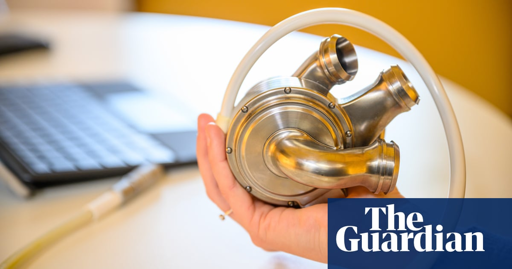I remember reading about this years ago. It’s so cool seeing it being used successfully in a patient! Technology like this makes me feel better about the future.
How does this handle activities that require increased blood flow? Does it have a little rheostat you crank to 11 when it’s time to go for a jog or something?
Did some fuckin’ Aussie heart surgeon just breeze into a Home Depot and saunter into the plumbing aisle in his board shorts and flips flops and just whip together a heart out of brass fittings and teflon tape???
“Oi! DANNY, YA FUCKIN’ BOGAN! I DONE DID YA UP A NEW RICKY TICKEY—ALL FUCKIN’ SHINEY AND CHROME!!! GRAB A CARPET KNIFE AND SOME DUNNY GLOVES—WE’ll GET THIS FUCKER INTO YOUR BLUDGER CHEST BEFORE YA SHEILA SAYS YA WERE CHUCKING A SICKIE!”

For orthopods though, using power tools and sledgehammers is pretty much the name of the game.
Not to belittle this accomplishment, but how is this a “World’s First” success?
Because I read the article I actually know the answer! It’s the first time this technology has been used in a human, and it’s been a huge success so far. Quote from the article
The BiVACOR total artificial heart, invented by Queensland-born Dr Daniel Timms, is the world’s first implantable rotary blood pump that can act as a complete replacement for a human heart, using magnetic levitation technology to replicate the natural blood flow of a healthy heart.
It would be nice if the article said if the artificial heart includes functions such as pumping harder in response to exercise and such, because it isn’t entirely clear if it does
Maybe it’s implied, but I feel it should be explicitly mentioned
Other prosthetic/mechanical changes to hearts don’t do that, so I would guess this one doesn’t either. It would require interfacing with the brain and decoding stimulus, which would be much more complex.
Usually the recipents just keep activity low or pass out when they need the energy/heat dissipation and can’t get it.
Yes exactly, so when they call it a “total heart replacement” I’d like to have clarification on it, so that I know how excited I should get
It’s frustrating when articles on new innovations don’t go into details about them at all except just “it exists” pretty much
Don’t know if you had your answer already, the artificial heart does pump harder when exercising




